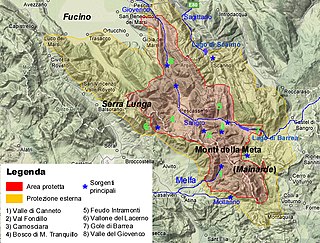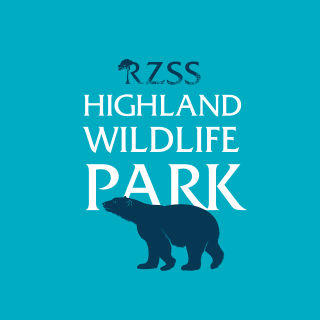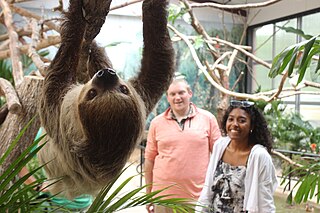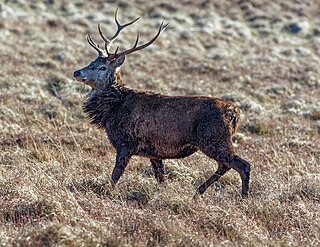
Connecticut's Beardsley Zoo, located in Bridgeport, Connecticut, is the only Association of Zoos and Aquariums (AZA)–accredited zoo in the state of Connecticut. The zoo includes one of the few carousels in the state. The zoo has around 500 animals, from over 100 species, and welcomes about 280,000 visitors a year.

The Retezat National Park is a protected area located in the Retezat Mountains in Hunedoara county, Romania. Founded in 1935, it is the oldest national park in the country and categorized as a category II IUCN national park.

Abruzzo, Lazio and Molise National Park is an Italian national park established in 1923. The majority of the park is located in the Abruzzo region, with smaller parts in Lazio and Molise. It is sometimes called by its former name Abruzzo National Park. The park headquarters are in Pescasseroli in the Province of L'Aquila. The park's area is 496.80 km2 (191.82 sq mi).

The Highland Wildlife Park is a 105-hectare (260-acre) safari park and zoo near Kingussie, Highland, Scotland. The park is located within the Cairngorms National Park. The park is run by the Royal Zoological Society of Scotland and is a member of the British and Irish Association of Zoos and Aquariums (BIAZA) and the European Association of Zoos and Aquaria (EAZA).

Elmwood Park Zoo is a zoo located in Norristown, Pennsylvania.

Fauna in Armenia is diverse given the country's relatively small geographic size, owing to the varied habitats created by the area's mountainous terrain. Armenia is an important area for migratory animals; about 350 different bird species were recorded in the country. Many of the world's domesticated animals originated in the area Armenia is located in, and the mouflon, the ancestor of domesticated sheep, is present there. Research suggests that about a quarter of the animal species in Armenia are internationally endangered. The mouflons are suffering a great population decline due to poaching and habitat loss, and the Sevan trout, which made up thirty percent of the fish in Lake Sevan, have virtually disappeared.

Namdapha National Park is a 1,985 km2 (766 sq mi) large national park in Arunachal Pradesh of Northeast India. The park was established in 1983. With more than 1,000 floral and about 1,400 faunal species, it is a biodiversity hotspot in the Eastern Himalayas. It harbours the northernmost lowland evergreen rainforests in the world at 27°N latitude. It also harbours extensive dipterocarp forests, comprising the northwestern parts of the Mizoram-Manipur-Kachin rain forests ecoregion.

The fauna of Scotland is generally typical of the northwest European part of the Palearctic realm, although several of the country's larger mammals were hunted to extinction in historic times and human activity has also led to various species of wildlife being introduced. Scotland's diverse temperate environments support 62 species of wild mammals, including a population of wild cats, important numbers of grey and harbour seals and the most northerly colony of bottlenose dolphins in the world.

The wildlife of Armenia includes the wild boar, crested porcupine, various lizards, snakes and numerous species of birds and plants. Endangered species in Armenia are the bear, wild goat, Armenian mouflon and the leopard.

The wildlife of Jordan includes its flora and fauna and their natural habitats. Although much of the country is desert, it has several geographic regions, each with a diversity of plants and animals adapted to their own particular habitats. Fossil finds show that in Palaeolithic times, the region had Syrian brown bears, Asiatic lions and Syrian elephants, but these species are all now extinct in this region.

The fauna of Europe is all the animals living in Europe and its surrounding seas and islands. Europe is the western part of the Palearctic realm. Lying within the temperate region, the wildlife is not as rich as in the hottest regions, but is nevertheless diverse due to the variety of habitats and the faunal richness of Eurasia as a whole.

ZooAmerica is a zoo located in Hershey, Pennsylvania, United States. It was founded in 1910 by Milton S. Hershey with a few animals, including bears, birds, and deer. Today, it covers 11 acres and is home to more than 75 species and 200 individual animals, including some that are rare and endangered.

Pakistan's native fauna reflect its varied climatic zones. The northern Pakistan, which includes Khyber Pakhtunkhwa and Gilgit Baltistan, has portions of two biodiversity hotspots, Mountains of Central Asia and Himalayas.

The West Virginia State Wildlife Center is a zoological park in French Creek, West Virginia. Operated by the West Virginia Division of Natural Resources, the Wildlife Center displays many of West Virginia's wildlife, including both native and introduced species. A few of the animals at the Wildlife Center were once found naturally in West Virginia, but were extirpated by the early 1900s.

Wingham Wildlife Park is a medium-sized wildlife park situated near Wingham, Kent, United Kingdom where it covers an area of 26 acres. In 2011, the species count at the park reached 180 species, growing to over 200 in 2013 covering fish, mammals, reptiles, amphibians, invertebrates and birds.

Sassnitz Wildlife Park is a wildlife park in the borough of Sassnitz on the German Baltic Sea island of Rügen.

The Atlantic mixed forests is a terrestrial ecoregion in western Europe. It extends along the western edge of continental Europe, from southwestern France through northern France, Belgium, the Netherlands, northwestern Germany, and western Denmark. Most of the region's forests and dunes have been converted to fields, pastures, and forest plantations, and its once-extensive wetlands have mostly been drained and filled.
The Chestnut Centre was a wildlife park near Chapel-en-le-Frith, Derbyshire, UK. It opened in 1984, and closed in 2017.
The Northumberland Zoo is a zoo in Felton, Northumberland, England.


















